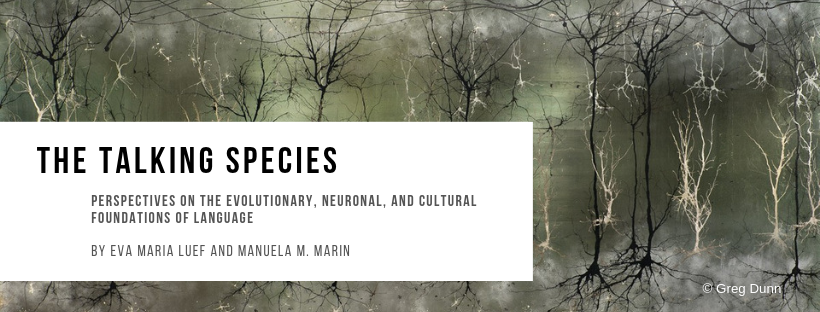
 |
01. Tracing the human brain’s classical language areas in extant and extinct hominids, p. 29
Eva Maria Luef
02. Times change, values change: Criteria for attributing language in species comparative research, p. 57
Robert Ullrich and Katja Liebal
03. From grasping to pointing: The evolution of referentiality in man and animals, p. 79
Adolf Heschl
04. Emotion communication in animal vocalizations, music and language: An evolutionary perspective, p. 105
Piera Filippi and Bruno Gingras
05. Speech processing in congenital amusia: A review of the literature and future directions, p. 127
Manuela M. Marin
06. The attainment of independence from the mother in primate infants and its implications for the evolution of cooperative breeding in hominins, p. 169
Iulia Bădescu
07. Nod, nod, ignore: An exploratory observational study on the relation between parental mobile media use and parental responsiveness towards young children, p. 195
Monika Abels, Mariek Vanden Abeele, Toke van Telgen and Helma van Meijl
08. Episodic and phenomenal aspects of chaotic itinerancy in language development, p. 229
Annette Hohenberger
09. Interfaces (traveling oscillations) + Recursion (delta-theta code) = Language, p. 251
Elliot Murphy
10. Lessons learned from brain responses: The second language learning experience, p. 273
Margit Reitbauer
11. The effect of age in L2 ultimate attainment: Revisiting the evidence, p. 291
Pia Resnik
12. Age constraints in phonological learning: On the relevance and efficiency of pronunciation training, p. 317
Milena Kong-Insam
13. Exploring the neurofunctional underpinnings of dyslexia: A review focusing on dyslexic children, p. 337
Sabrina Turker
14. HEAFOD (‘head’) and BRÆGEN (‘brain’) in Old English medical texts, p. 377
Peter Bierbaumer
15. The brain is like a muscle – the brain is like a control center: Conceptualizing the brain in expert and popularized scientific discourses, p. 393
Georg Marko and Ute Wimmer
16. The humble linguist: Interdisciplinary perspectives on teaching intercultural citizenship, p. 423
Manuela Wagner, Fabiana Cardetti and Michael Byram
17. Frames, cognition, ideology. And Chomsky, p. 449
Johannes A. Scherling
18. Monats- und Wochentagsbezeichnungen im Wandel der Zeit, p. 469
Wolfgang Viereck
Annemarie Peltzer-Karpf: An Appreciation, p. 485
Nancy Campbell
Tabula Gratulatoria, p. 489
Index, p. 491